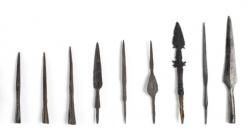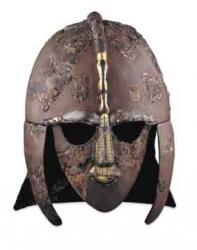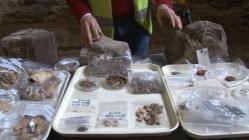INSTITUT SUPERIEUR D'ANTHROPOLOGIE
INSTITUTE OF ANTHROPOLOGY
ONLINE COURSES / COURS A DISTANCE
SUMMER TERM : JULY 2014
REGISTER NOW
INDE - Piralimattam cave -The unearthing of historical relics from Piralimattam cave, an archaeological site near here, has given strength to the long-time demand of the residents who have been demanding conservation of the cave.During a site visit, P Rajendran, a noted archaeologist and UGC research scientist, has said that the site is of immense historical significance as some of the inscriptions dating back to neolithic age were found in the cave. Rajendran told ‘City Express’ that the cave was over 4000 years old. “The inscriptions on the walls are man made and the primary study hints that most of the inscriptions belonged to neolithic era or stone age,” he said.. Rajendran added that three caves bore man-made petroglyphs. “Over five inscriptions among the 14 ones have been identified man made. The remaining will soon be identified. The site has the potential to provide rich information about the life of people dating back to more than 4,000 years ago,” he added. Rajendran said that the new findings point out that if the State Archaeology Department launches an excavation mission, more valuable historical evidence can be obtained.
http://www.newindianexpress.com/states/kerala/Inscriptions-Discovered-at-Piralimattam-Cave/2014/04/10/article2159258.ece#.U0axzfl_vVQ
IRLANDE –  Clontarf - The Battle of Clontarf was fought, we are told, on Good Friday – April 23rd – 1014. TheNational Museum of Ireland is marking its 1,000th anniversary with ‘Clontarf 1014: Brian Boru and the Battle for Dublin’, an exhibition that opens today. In preparing for it we were faced with the fact that we have no direct archaeological evidence for the battle – not a single weapon or any other item of militaria that is definitely associated with it. This is not to doubt that it happened. There are many legitimate explanations for the lack of evidence. Medieval battlefields were typically picked clean shortly after the fighting ended. Weapons and armour were far too valuable to be left lying around and would have been gathered up by the winning side or by locals. The bodies of the slain were usually buried in mass graves, often some distance from the site of the battle. So it may be unreasonable to expect direct evidence of the battle to survive at Clontarf. In any event, the site of the battle has never been definitively established. Clontarf itself – and the whole Dublin Bay area – has changed dramatically in the past 1,000 years, because of reclamation of the bay and the growth of the city. This makes locating where the battle took place very difficult. We may never know its precise location. Archaeology, however, tells us a lot about the weapons and armour that both sides would have used in 1014. Excavation in Viking Dublin over the past 50 years has shown the city’s warriors used swords, axes, spears and bows and arrows at the time. Evidence from elsewhere in Ireland, especially finds from lakes and rivers, shows the Irish were using Viking-type swords, axes and spears. Both Irish and Viking warriors would have used large round wooden shields. With the exception of the bow and arrow, which the Irish appear not to have used, there was probably little difference between the weapons used by Irish and Viking warriors. Another significant difference was that many Viking warriors probably had mail armour, whereas the Irish rarely did. Archaeological evidence from Dublin suggests that it had the most advanced military technology available in 1014. The fact that Brian Boru managed to defeat such formidable opponents (albeit at huge cost) says a lot about how far Irish kings had gone by 1014 to make up any military shortcomings that may have existed in the early Viking period.
Clontarf - The Battle of Clontarf was fought, we are told, on Good Friday – April 23rd – 1014. TheNational Museum of Ireland is marking its 1,000th anniversary with ‘Clontarf 1014: Brian Boru and the Battle for Dublin’, an exhibition that opens today. In preparing for it we were faced with the fact that we have no direct archaeological evidence for the battle – not a single weapon or any other item of militaria that is definitely associated with it. This is not to doubt that it happened. There are many legitimate explanations for the lack of evidence. Medieval battlefields were typically picked clean shortly after the fighting ended. Weapons and armour were far too valuable to be left lying around and would have been gathered up by the winning side or by locals. The bodies of the slain were usually buried in mass graves, often some distance from the site of the battle. So it may be unreasonable to expect direct evidence of the battle to survive at Clontarf. In any event, the site of the battle has never been definitively established. Clontarf itself – and the whole Dublin Bay area – has changed dramatically in the past 1,000 years, because of reclamation of the bay and the growth of the city. This makes locating where the battle took place very difficult. We may never know its precise location. Archaeology, however, tells us a lot about the weapons and armour that both sides would have used in 1014. Excavation in Viking Dublin over the past 50 years has shown the city’s warriors used swords, axes, spears and bows and arrows at the time. Evidence from elsewhere in Ireland, especially finds from lakes and rivers, shows the Irish were using Viking-type swords, axes and spears. Both Irish and Viking warriors would have used large round wooden shields. With the exception of the bow and arrow, which the Irish appear not to have used, there was probably little difference between the weapons used by Irish and Viking warriors. Another significant difference was that many Viking warriors probably had mail armour, whereas the Irish rarely did. Archaeological evidence from Dublin suggests that it had the most advanced military technology available in 1014. The fact that Brian Boru managed to defeat such formidable opponents (albeit at huge cost) says a lot about how far Irish kings had gone by 1014 to make up any military shortcomings that may have existed in the early Viking period.
http://www.irishtimes.com/culture/heritage/no-weapons-no-battlefield-no-bodies-1.1755853
ROYAUME UNI –  Sutton Hoo - Cate Blanchett serait actuellement en pleine discussion pour être à l’affiche du prochain film de la réalisatrice Susanne Bier. Un drame qui raconterait l’histoire vraie de la plus célèbre découverte archéologique britannique : le cimetière de Sutton Hoo. Adapté du livre éponyme, The Dig explorera cette découverte des années 1938 et 1939, à travers l’histoire des archéologues. L’actrice, récompensée par l’Oscar de la meilleure actrice pour Blue Jasmine, devrait interpréter le rôle d’Edith Pretty, une archéologue amateur. Le film est prévu pour la fin de l’année 2014.
Sutton Hoo - Cate Blanchett serait actuellement en pleine discussion pour être à l’affiche du prochain film de la réalisatrice Susanne Bier. Un drame qui raconterait l’histoire vraie de la plus célèbre découverte archéologique britannique : le cimetière de Sutton Hoo. Adapté du livre éponyme, The Dig explorera cette découverte des années 1938 et 1939, à travers l’histoire des archéologues. L’actrice, récompensée par l’Oscar de la meilleure actrice pour Blue Jasmine, devrait interpréter le rôle d’Edith Pretty, une archéologue amateur. Le film est prévu pour la fin de l’année 2014.
http://www.ninapeople.com/cate-blanchett-star-dun-drame-de-susanne-bier/128514/
ROYAUME -UNI – Maryport -A town dating back nearly 2,000 years has been uncovered near Maryport in Cumbria. The site near to a Roman Fort has been explored before but a new archaeological dig has already uncovered extra material to help explain life in the 2nd and 3rd Centuries. The dig will go on for the next two months. Local volunteers and people from outside the area are helping archeologists to unearth what's been lying undisturbed for two millennia.
http://www.itv.com/news/border/update/2014-04-10/roman-town-is-uncovered-in-maryport/?
ROYAUME UNI –  Durham - Archaeologists have discovered evidence of a Roman settlement on the site of Durham Cathedral. The Cathedral’s own archaeologist, Norman Emery, is working with a team of specialists from Durham University. "The pottery is very interesting because it makes you wonder if there could have been a Roman site here on the Cathedral peninsula... We know there was a site not too far away called Old Durham, on the other side of the river, but several Roman artefacts have been found in this area previously, so combined with these finds, this could suggest that there was a site much closer to home.” (N. Emery, Durham Cathedral Archaeologist)
Durham - Archaeologists have discovered evidence of a Roman settlement on the site of Durham Cathedral. The Cathedral’s own archaeologist, Norman Emery, is working with a team of specialists from Durham University. "The pottery is very interesting because it makes you wonder if there could have been a Roman site here on the Cathedral peninsula... We know there was a site not too far away called Old Durham, on the other side of the river, but several Roman artefacts have been found in this area previously, so combined with these finds, this could suggest that there was a site much closer to home.” (N. Emery, Durham Cathedral Archaeologist)
http://www.itv.com/news/tyne-tees/update/2014-04-10/roman-pottery-discovered-at-durham-cathedral/?
ROYAUME UNI –  Nottingham - Archaeologists have discovered column bases from Lenton Priory and the walls of a medieval building during excavations for the new tram route.The discovery was made at a site behind The White Hart, in Gregory Street, where works to the track beds are being finalised. Mr Flintoft added that the team were carefully removing the soil layer by layer when the discovery of a series of medieval walls were made at the end of last week. This was then followed by the discovery of two floors, one made of cobble, likely to be a yard, and one made of thin mortar, likely to be a part of the building’s interior. The archaeologist added: “I think we have clipped part of a building. I think people have been living here and it is part of a medieval domestic occupation. It is really exciting.” A column base was also discovered at the site, which Mr Flintoft believes is from Lenton Priory. Two other column bases from the Priory were also found in Gregory Street. Lenton Priory, founded in 1106-7, was the largest church and monastery in the region. It was closed on the orders of Henry VIII in 1538, and almost all its buildings demolished.
Nottingham - Archaeologists have discovered column bases from Lenton Priory and the walls of a medieval building during excavations for the new tram route.The discovery was made at a site behind The White Hart, in Gregory Street, where works to the track beds are being finalised. Mr Flintoft added that the team were carefully removing the soil layer by layer when the discovery of a series of medieval walls were made at the end of last week. This was then followed by the discovery of two floors, one made of cobble, likely to be a yard, and one made of thin mortar, likely to be a part of the building’s interior. The archaeologist added: “I think we have clipped part of a building. I think people have been living here and it is part of a medieval domestic occupation. It is really exciting.” A column base was also discovered at the site, which Mr Flintoft believes is from Lenton Priory. Two other column bases from the Priory were also found in Gregory Street. Lenton Priory, founded in 1106-7, was the largest church and monastery in the region. It was closed on the orders of Henry VIII in 1538, and almost all its buildings demolished.
http://www.nottinghampost.com/Column-bases-Lenton-Priory-discovered-excavation/story-20942891-detail/story.html